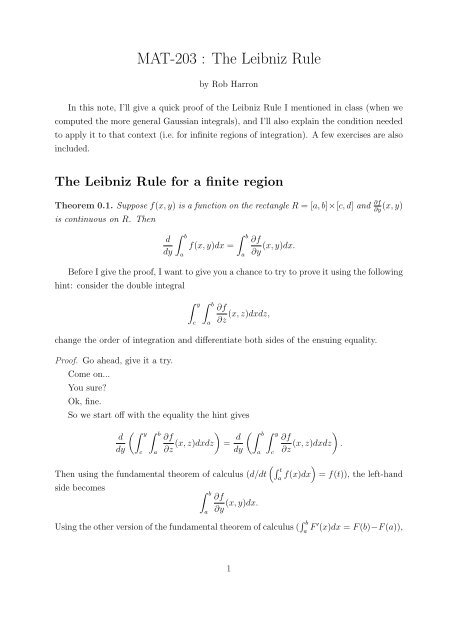MAT-203 : The Leibniz Rule
MAT-203 : The Leibniz Rule
MAT-203 : The Leibniz Rule
You also want an ePaper? Increase the reach of your titles
YUMPU automatically turns print PDFs into web optimized ePapers that Google loves.
<strong>MAT</strong>-<strong>203</strong> : <strong>The</strong> <strong>Leibniz</strong> <strong>Rule</strong><br />
by Rob Harron<br />
In this note, I’ll give a quick proof of the <strong>Leibniz</strong> <strong>Rule</strong> I mentioned in class (when we<br />
computed the more general Gaussian integrals), and I’ll also explain the condition needed<br />
to apply it to that context (i.e. for infinite regions of integration). A few exercises are also<br />
included.<br />
<strong>The</strong> <strong>Leibniz</strong> <strong>Rule</strong> for a finite region<br />
<strong>The</strong>orem 0.1. Suppose f(x, y) is a function on the rectangle R = [a, b]×[c, d] and ∂f<br />
(x, y) ∂y<br />
is continuous on R. <strong>The</strong>n<br />
d<br />
dy<br />
b<br />
a<br />
f(x, y)dx =<br />
b<br />
a<br />
∂f<br />
(x, y)dx.<br />
∂y<br />
Before I give the proof, I want to give you a chance to try to prove it using the following<br />
hint: consider the double integral<br />
y b<br />
c<br />
a<br />
∂f<br />
(x, z)dxdz,<br />
∂z<br />
change the order of integration and differentiate both sides of the ensuing equality.<br />
Proof. Go ahead, give it a try.<br />
Come on...<br />
You sure?<br />
Ok, fine.<br />
So we start off with the equality the hint gives<br />
d<br />
y b<br />
dy c a<br />
<br />
∂f<br />
(x, z)dxdz =<br />
∂z d<br />
dy<br />
b y<br />
a<br />
c<br />
<br />
∂f<br />
(x, z)dxdz .<br />
∂z<br />
t<br />
<strong>The</strong>n using the fundamental theorem of calculus (d/dt a f(x)dx<br />
<br />
= f(t)), the left-hand<br />
side becomes b<br />
a<br />
∂f<br />
(x, y)dx.<br />
∂y<br />
Using the other version of the fundamental theorem of calculus ( b<br />
a F ′ (x)dx = F (b)−F (a)),<br />
1
the right-hand side becomes<br />
b<br />
<br />
d<br />
(f(x, y) − f(x, c))dx ,<br />
dy a<br />
and the second part of the integrand (f(x, c)) is independent of y, so it’s derivative with<br />
respect to y is 0, thus the right-hand side is<br />
as desired.<br />
b <br />
d<br />
f(x, y)dx ,<br />
dy a<br />
Exercise: Using this theorem and the chain rule, prove the more general formula<br />
d<br />
dy<br />
g2(y)<br />
g1(y)<br />
f(x, y)dx =<br />
g2(y)<br />
g1(y)<br />
assuming, in addition, that g1 and g2 are differentiable.<br />
Exercise: Compute<br />
Hint: Define I(α) := 1<br />
0<br />
need that limα→0 I(α) = 0.<br />
∂f<br />
∂y (x, y)dx + g′ 2(y)f(g2(y), y) − g ′ 1(y)f(g1(y), y)<br />
1<br />
0<br />
x − 1<br />
log x dx.<br />
xα−1dx for α > 0, and use the <strong>Leibniz</strong> rule. At some point, you’ll<br />
log x<br />
<strong>The</strong> <strong>Leibniz</strong> <strong>Rule</strong> for an infinite region<br />
I just want to give a short comment on applying the formula in the <strong>Leibniz</strong> rule when the<br />
region of integration is infinite. In this case, one can prove a similar result, for example<br />
d<br />
dy<br />
∞<br />
∞<br />
f(x, y)dx =<br />
0<br />
0<br />
∂f<br />
(x, y)dx,<br />
∂y<br />
like the one we used in class, but we need to add a condition on f. Basically, we need to<br />
make sure that ∂f/∂y is well-behaved as x goes to infinity. <strong>The</strong> condition is the following:<br />
there is a positive function g(x, y) that is integrable, with respect to x, on [0, ∞), for each<br />
y, and such that | ∂f<br />
(x, y)| ≤ g(x, y) for all (x, y). (In a more general context, this theorem<br />
∂y<br />
is a corollary of the Lebesgue Dominated Convergence <strong>The</strong>orem).<br />
2
















